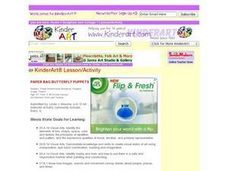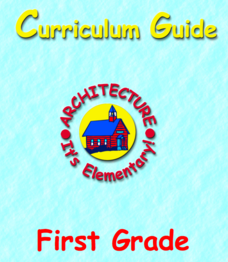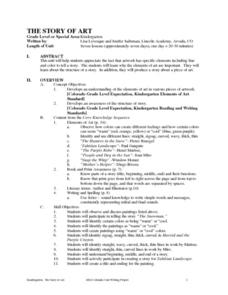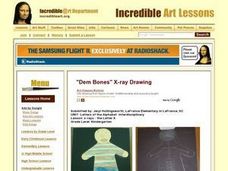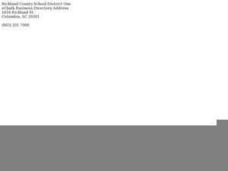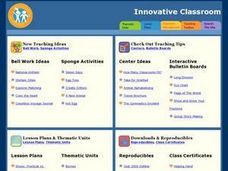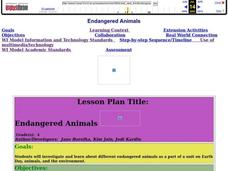Curated OER
Paper Bag Butterfly Puppets
Whether you're using it to tell stories, explore the letter b, or during a life science lesson plan, these butterfly puppets will be a hit. Youngsters use crayons, tissue paper, and paper bags to create butterfly puppets.
Curated OER
The Letter B
Students read books, play internet games, and trace letters to learn about the letter b. In this letter b lesson plan, students also make bear crafts.
Curated OER
The Scarlet Letter
The Scarlet Letter is a treasure trove of topics awaiting exploration by readers of Nathaniel Hawthorne's romantic opus. Whether looking for imagery (light/dark, mirror, scarlet letters), symbols (static or evolving), ironies, etc.,...
American Institute of Architects
Architecture: It's Elementary!—First Grade
Build an interest and appreciation for architecture in your young learners with this fun 10-lesson art unit. Engaging children in using their five senses, the class first observes the environment around them, paying...
Curated OER
Letter Names
Students explore language arts by participating in a letter identification activity. In this word recognition lesson, students are shown a list of vocabulary terms which they practice reciting with their classmates. Students identify and...
Curated OER
The Story of Art
Students canvass the important elements of art in the seven lessons of this unit. Story structure and in particular, color is perceived as essential to the development of the idea of a picture.
Curated OER
x-rays - the Letter X
Students demonstrate the ability to draw vertical, horizontal, and diagonal lines, recognize the difference between inside and outside, and create a picture of themselves.
Curated OER
Where in the World is Flat Stanley?
Second graders analyze the proper form of a friendly letter and send flat Stanley letters all over the United States. In this letter writing lesson, 2nd graders read the book Flat Stanley by Jeff Brown and create their own Flat...
Curated OER
Librarian
Students read books, learn about the letter l, and eat pudding all to learn about how to act in a library. In this library lesson plan, students also practice tip toeing around the room.
Curated OER
Blending Bunnies
Students use the short /a/ sound to blend letters and form words. They use enlarged copies of bunnies with different letters written on them. They combine the "bunnies" to spell words with the short /a/ sound, and then read the words...
Desert Discoveries
Sonoran Desert ABC's
Third graders make alphabet cards that depict the wide variety of life forms found in the Sonoran Desert. A terrific lesson that combines language arts, visual arts, and life science all into one wonderful package. Each of the cards has...
Curated OER
Money Madness
Second graders review coins and their values. In this coin recognition lesson, 2nd graders review the coin values as they read 'Smart' by Shel Silverstein. Students use class computer demonstrations to identify the coin's names, worth,...
Curated OER
Tricks of the Trade A Collection of Concrete Poems-for writing concrete poems
Students explore concrete poetry. In this lesson about poetry, students read A Poke in the I, by Paul B. Janeczko, and are introduced to concrete poems. Students read several different kinds of concrete poems including single-word, and...
Curated OER
The Archer and The Sun
First graders explore Chinese folktales. In this Chinese folktale lesson ,students read Chinese folktales, locate China on a map, and color the Chinese flag. Students are given sentence strips to hold and must arrange themselves in...
Curated OER
Macaroni Pattern Necklaces
Students create a macaroni necklace based on a pattern given them by the instructor. In this reinforcement lesson, students are given a complex pattern and using a letter key. They must recreate the patten using colored macaroni strung...
Curated OER
Honey Bees!
Students research and complete two assignments about honeybees. Students draw and color a picture of a flower with a honeybee inside of it. Students write a letter to the executives at Ridit Pest Control persuading them to stop the...
Curated OER
Sound Stretching
In this basic vowel and consonant blending lesson, young learners are shown how to "blend" the sounds of different letters together in order to make a word. Simple words such as, "sun," "moon," and, "ant," are used in a whole-class setting.
Curated OER
Spinning Short Vowel Game
First graders, in pairs, use spinners to experiment with different combinations of letters. They combine letters and determine whether they have produced a word or not. They construct and record words choosing letters from designated tiles.
Curated OER
Using Numbers Everywhere
Kindergarteners explore various representations and uses of numbers to develop number sense. They participate in an activity and arrange patterns into groups. Students compare the sets and describe the objects in each set.
Curated OER
Blending Buddies
Students put word cards together and use the word parts to create correct words. In this phonics lesson plan, students practice pronouncing consonant blends and vowel sounds, demonstrating an awareness of beginning, middle, and ending...
Curated OER
A Sentence for Life
What is a sentence? Second graders will explore the components of a sentence in the ten lessons of this unit. The subject, predicate, the process of proofreading, punctuation, and sentence sequence are analyzed in this unit. Handouts and...
Curated OER
Elements of A Story
Eighth graders read stories and identify the six elements of a story. As a group activity, they illustrate random examples of Frankinstein stories, identify the element illustrated, and post the picture in the appropriate station in the...
Curated OER
Endangered Animals
Fourth graders research different endangered animals in media center as part of unit on Earth Day, animals, and environment, create project based around multiple intelligence related to an endangered animal, and produce Powerpoint...
Curated OER
The Magic of Algebra: Original Lesson Plan
Young scholars participate in a teacher led math "trick." The teacher "reads the mind of the students. The answer to the problem is always 4, and by following the directions, the teacher can guess that young scholars are thinking of...
